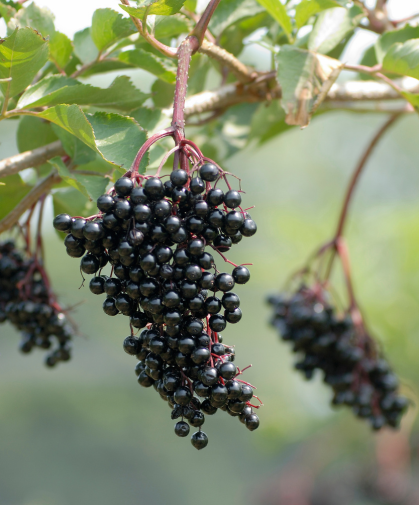Elderberry - Key Growing Information

SCIENTIFIC NAME:
Sambucus nigra CULTURE:
Elderberries perform best in full sun and consistently moist, fertile, well-drained soils. Raised beds are an option if your site is poorly drained. Elderberries prefer soil with a pH between 5.5 and 6.5.PLANTING:
Adequate spacing is important for best yields. Beds should be approximately 2' wide and 10–12' apart. Space plants 3–6' apart in the row. Transplant plugs deeply enough to cover plug soil with 1/2–1" garden soil. Irrigate well after transplanting and maintain good moisture levels. Elderberries will not tolerate drought conditions. Proper soil moisture is essential during the establishment-year and drip irrigation is the best method. After establishment, from flowering through harvest, plants should receive a minimum of 1" of water per week for optimal fruit production. Mulch plants with a 2–3" layer of straw or wood chips to aid in moisture retention, discourage weed growth, and contribute more organic matter to the soil. To avoid damaging the fibrous, shallow root system, do not cultivate deeply. POLLINATION:
While self-fertile, elderberries benefit greatly from the cross-pollination of another variety. This will substantially increase yields. We recommend 1 pollinator plant for every 5 plants for optimal production. Note: our Elderberry Plant Collection includes a pollinator. FERTILITY:
Elderberries do not require fertilizer during the establishment year as they derive many of the nutrients they require from existing organic matter in the soil. In subsequent years, fertilize at the beginning of the season with a 10-10-10 fertilizer (or equivalent) or compost. PRUNING:
Elderberries are a very fast-growing, shrub-type plant with a "suckering" plant habit. Plants can quickly become unruly without regular pruning. Pruning can be approached in a few ways. Most commonly, remove dead or weak stems annually in the late winter/early spring (February to March) when plants are still dormant. Another effective pruning method is to trim stems back by about 1/3rd, essentially "topping" the plant uniformly all over. Lastly, if plants become unmanageable, cut all stems to the ground to completely rejuvenate. This method will not harm well-established plants. HARVEST:
Elderberries will bear a harvestable crop beginning in their 2nd year. In late summer, harvest whole clusters of berries by clipping them from the shrub. Use the fruit as soon as possible or refrigerate for later use. Strip the berries from the cluster stems before processing. CAUTION:
Berries are toxic if eaten raw. They must be cooked prior to consumption. Elderberry fruits, leaves, stems, and roots contain cyanogenic glycosides which can make people and livestock very ill if consumed raw. Elderberry flowers, however, are non-toxic and can be harvested and are commonly used.PESTS & DISEASE: Elderberry plants are generally free of disease and insect pests. Use bird netting to protect fruit. SPECS: Approx. 25 plants/100' row, or approx. 850 plants/acre at 5' spacing, rows 10' apart.

